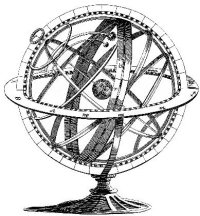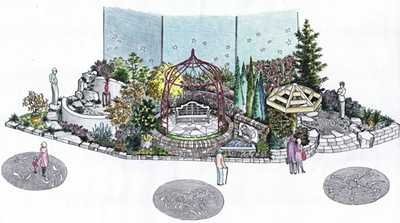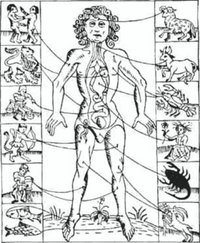





Following lunar phases in the garden is the first step down a more obscure path . According to occult gardeners, there is as much significance in the moon's traverse of the astrological wheel. Through both the Zodiac & Aristotle's system of four elements, fortunes in the garden are foretold in the stars. Or so some say. Old wives' tales or esoteric wisdom? It's time to explore this next level & find out for ourselves.
Western thinking demands cause & effect relationships. We like to know what everything is & why. When we don't understand the cause of a phenomenon, we call it unexplained or even, reject its existence altogether. Consequently when dealing with astrology, it is important to remember that it does not describe cause & effect relationships. In other words, astrologers do not think the stars & planets directly influence life on Earth. Instead, signs are studied in the belief they may mark a pattern, not unlike the way a clock's hands mark time. Why patterns in the stars might correlate with events on Earth is not something astrologers attempt to explain. No-one knows but for a long time, people have believed in such coincidental patterns.
Of course, the Zodiac is not the only cosmic wheel. There are alternate versions like the Chinese astrological calendar & ancient, related belief systems such as Elementalism. Since the days of Classical Greece, many people have believed all matter to be compromised of four elements: Earth, Fire, Air & Water. At some point this system became married to astrology, each sign being attributed an elemental nature. The keys to zodiac gardening lay in recognising the elements represented by each sign as the moon traverses them in different phases.

Taurus

Virgo

Capricorn
Earth is perhaps the most vital element, particularly to growers. Zodiac gardeners associate it with development below the ground ie. root vegetables & root growth. The astrological signs believed to represent the earth element are Taurus, Virgo & Capricorn. A waning moon traversing an earth sign indicates what are traditionally known as Root Days. In real terms, a Root Day would last about two days & since planting in the last quarter is considered ill-advised, these would only fall whilst the moon is in the third quarter.
A small amount of research has been done planting potatoes & other vegetables under different moons, in different signs. E.A. Crawford, author of "The Lunar Garden: Planting by the Moon Phases", informs us ...
"The person most responsible for formal experimentation in this area is Maria Thun (sic). Maria Thun sowed according to varying phases of the lunar cycle. Once the crop came to maturity, it was weighed and studied, and the results were recorded. Thun's findings were accumulated over a ten-year period from 1952 to 1962 (sic). Thun's results were surprising. She discovered that if potatoes were planted when the moon was in the constellations of Taurus, Capricorn or Virgo (traditionally termed "root days"), the crop was more prolific than if she planted when the moon was positioned in other constellations of the zodiac belt. After some thought, she concluded that potatoes did better if planted while the moon was clearly positioned in earth signs than at any other time. Potato crops planted when the moon was positioned in the constellations Cancer, Scorpio or Pisces--the water signs of the zodiac--did poorly." [1]
Logically speaking of course, there is no plausible connection between the Moon's passage across distant constellations & the fate of potatoes; or any vegetable for that matter. For this reason, we must recall that we are looking for natural cues, rather than causes. If as many claim Root Days are founded, the fact would merely point to indirect natural processes we are yet to grasp.

Sagitarius

Aries

Leo
Fire is a barren element, viewed with trepidation toward planting by many astrological growers. By the same token, fire signs are considered the correct ones under which to weed & turn soil. The signs believed to represent fire are Sagitarius, Aries & Leo.
Whilst fire is seen as dry & infertile, the taboo against planting under its signs is not without exception. A convention of Fruit Days exists, by which fruiting trees & vegetables may be planted under waxing moons & pruned under waning ones. [2] Also under waning moons, grafting, fertilising & harvesting for seed are recommended activities, whilst sap is drawn to root. Following the same logic, the author suggests that planting cacti & succulents - infamously prone to root rot - may be done appropriately on Fruit Days. Perhaps this could even apply to Frangipani or Plummeria cuttings. Again taking the pragmatic approach, if the notion gets results it becomes irrelevant whether we understand why. After all, it is more likely that our ancestors noticed events on Earth before looking to the heavens for an indicator, than vice-versa.


Gemini

Libra

Aquarius
Air is also considered a dry element, but less barren than Fire. Its signs are Gemini, Libra & Aquarius. Some zodiac growers consider Libra to be more vital than its two elemental companions, often calling it a semi-fertile sign. Lunar crossing Air signs is said to indicate Flower Days; waxing moons as usual, meant for sowing & waning for pruning, replanting & fertilising. Cutting flowers & storing bulbs are activities also done on Flower Days under waxing moons, whilst grafting flowering shrubs & trees is recommended after the full moon.[2]
The exact distinction between flowering & fruiting in the case of many plants is unclear. Since yield normally depends upon flowering, it seems logical that a fruiting species might perform as well planted under air as fire. About this issue, E. A. Crawford explains ...
"Maria Thun examined ancient and medieval theories of planting by the zodiac and began to work with them in experimental conditions (sic). She concluded that each plant is composed of four essential parts: leaf, root, flower and fruit or seed. Each plant is cultivated to yield one of the four qualities. Tomatoes, for instance, are a fruit or seed crop; nasturtiums are a flower crop." [1]
This does seem a simplistic approach in one way but of course, it attempts only to describe a barely studied pattern. Importantly, it leaves much grey area to experiment in; especially for gardeners growing plants for unconvential purposes. Canna lilies for foliage rather than flower, chicory for its root & ornamental fruit trees are examples that spring to mind. In this regard, garden designs based on the astrological wheel would be ideal for experimention. These have been built for garden shows, are an interesting style & would be enjoyable to play around with.

Zodiac Gardens, Portland Home & Garden Show. Image courtesy of Astrology on the Web

cancer

Scorpio

Pisces
We return to a fertile element in water, which is believed to be represented by the signs Cancer, Scorpio & Pisces. Readers may guess by this point that the element is connected to Leaf Days. Following the normal rules, leafy vegetables & plants otherwise grown for foliage are planted under waxing moons traversing water signs. Replanting, fertilising & pruning are saved for waning moons. Some zodiac gardeners count cabbage varieties amongst leaf vegetables, though in the cases of cauliflower & broccoli - the flowers of which are normally eaten - this assertion is questionable. As with fruiting plants, a gardener might experiment here with air signs. Leaf herbs such as mint & sage are included also, along with grasses & non-flowering hedges.
When it comes to harvesting leaf vegetables, the same principles apply as with fruit & flowers. If fresh leaves are wanted pick them under water signs, close to the full moon where possible. If the intention is to store dried herbs or something similar, harvest under air or fire, preferrably when the moon is new.
Experience is said to have shown that not all plants follow the normal elemental rules. Specific varieties have unexpected astrological preferences & are treated accordingly. Melons for example, are thought to perform better in association with Gemini, whilst onions are reputed to thrive under Aquarius. There are many other examples & a chart listing them at Gardeningbythemoon, which also features other information such as frost tolerances.

Of course, there is much more to gardening & farming than planting & harvesting. Caren Catteral, the creator of Gardeningbythemoon.com tells us ...
"Other garden chores have preferences for the sign also, such as pruning in Scorpio, weeding in Leo. Harvesting in the dry air and fire signs in the fourth quarter helps preserve fruit and vegetables for storage."
Agricultural chores are also a common theme amongst medieval calendars & astrological tomes, though the basis here is traditionally more anthromorphological than elemental. In other words, these observe a system by which astrological signs are linked to body parts & assigned to various labours at different astrological junctures. [3]
 Aries is traditionally associated with the head
Aries is traditionally associated with the head
 Taurus is associated with the neck
Taurus is associated with the neck
 Some sources connect Gemini to arms & hands. Others associate the signs with nerves.
Some sources connect Gemini to arms & hands. Others associate the signs with nerves.
 The water sign Cancer is related to the stomach
The water sign Cancer is related to the stomach
 Leo is said to relate to the heart
Leo is said to relate to the heart
 Virgo is said to be connected to intestines
Virgo is said to be connected to intestines It is thought that Libra is connected to the back
It is thought that Libra is connected to the back
 Scorpio is thought to rule the genitals
Scorpio is thought to rule the genitals
 The archer is associated with the hips
The archer is associated with the hips
 Capricorn is related to the legs & to skin
Capricorn is related to the legs & to skin
 Aquarius is connected to shins
Aquarius is connected to shins
 Pisces is associated with feet
Pisces is associated with feet
One old tradition practiced by farmers in the US & other countries, is weaning calves whilst the moon is in certain signs. [4] According to various sources including members of Dave's Garden, these are signs "below the knees". ie. Pisces, Aquarius & Capricorn, with some sources including Sagitarius. [5] Farmers' almanacs have been used to chronicle such traditions over the years & can still be consulted for information like Best Days for various agricultural chores.
Plotting the course of the moon & other planets is where astrologers earn their keep. Books of planetary positions known as ephemerides can be used, but are more usually employed when calculating nativity charts. Farmers' almanacs are handy again here as they are one of the easiest methods. Astrology newsletters & sites such Zodiacarts.com are another way. What benefit would be gained by following these signs is hard to say, but many growers to stand by it. Either way, zodiac gardening does offer a routine, a chance to experiment & a fun theme for garden designs.
Copyright © www.100flowers.win Botanic Garden All Rights Reserved